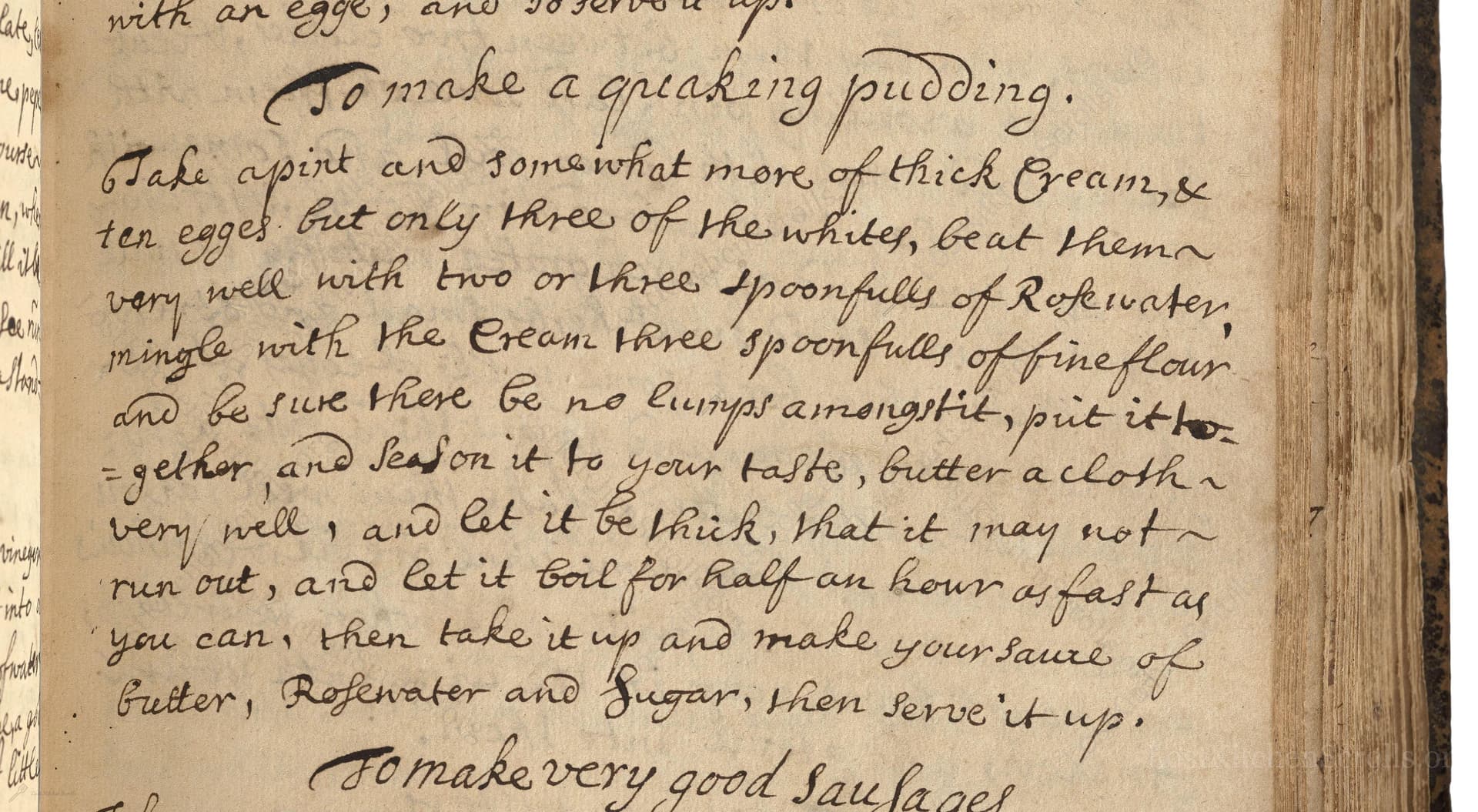To Make A Speaking Pudding
From the treasured pages of Cookbook
Unknown Author

To Make A Speaking Pudding
"Take a pint and somewhat more of thick Cream, & ten egges but only three of the whites, beat them very well with two or three spoonfulls of Rosewater, mingle with the Cream three spoonfulls of fine flour and be sure there be no lumps amongst it, put it to=gether, and season it to your taste, butterr a cloth very well, and let it be thick, that it may not run out, and let it boil for half an hour as fast as you can, then take it up and make your sauce of Butter, Rosewater and Sugar, then serve it up."
Note on the Original Text
The recipe is composed in loose, prose style—no bullet points, no precise measurements, only the familiar reference points of the Georgian kitchen. Spelling and grammar are of their time, with instructions like 'put it together' covering everything from mixing to seasoning. Notably, the term 'thick cream' refers to unhomogenized double cream, richer than most modern supermarket cream. The omission of exact temperatures and times is common; a cook was expected to know their own hearth and the properties of their tools. The cryptic 'speaking' in the pudding's name may refer to its delicate, almost ethereal texture—so tender it might 'speak' with each bite.

Title
Cookbook (1706)
You can also click the book image above to peruse the original tome
Writer
Unknown
Era
1706
Publisher
Unknown
Background
Step back to the early 18th century with this charming culinary collection, brimming with period recipes that tantalize the tastebuds and offer a delicious glimpse into historic kitchens.
Kindly made available by
Folger Shakespeare Library
This recipe comes from an English manuscript dated around 1706, a period famous for its elaborate dairy puddings and a love of fragrant waters like rosewater. 'Speaking pudding' is representative of the era’s penchant for rich, custardy desserts served with buttery, scented sauces at the end of formal meals. Recipes like this often dotted the tables of upper- and middle-class households, reflecting both culinary skill and access to luxury imports such as rosewater and sugar.

Historically, the cook would have used a large mixing bowl, coarse muslin or linen pudding cloth, and a sturdy string to tie it up. The beaten eggs and cream mixture would be mixed with a wooden spoon or whisk (known as a 'whisk' even then). For boiling, a heavy iron or copper pot filled with water, hung over an open fire, provided the necessary heat. The sauce would be prepared in a small pan over the hearth.
Prep Time
20 mins
Cook Time
30 mins
Servings
8
We've done our best to adapt this historical recipe for modern kitchens, but some details may still need refinement. We warmly welcome feedback from fellow cooks and culinary historians — your insights support the entire community!
Ingredients
- 1 pint (2 cups) thick double cream
- 10 eggs (use 7 yolks and 3 whole eggs)
- 1.5 fl oz (3 tablespoons) rosewater
- 1 oz (3 tablespoons) plain flour
- Butter (for cloth and sauce, about 2.5 oz total)
- Sugar (to taste, for pudding and sauce)
- Pinch salt
- Cloth or muslin for boiling (roughly 20x20 inches)
Instructions
- To recreate 'speaking pudding' in a modern kitchen, begin by whisking 1 pint (2 cups) of thick double cream with seven egg yolks and three whole eggs.
- Add 3 tablespoons (1.5 fl oz) of rosewater and beat until smooth.
- Sift in 3 tablespoons (about 1 oz) of plain flour, ensuring there are no lumps, then mix thoroughly.
- Season with a pinch of salt and sugar to taste.
- Generously butter a clean pudding cloth (or a double layer of muslin), making sure it's thick so the batter doesn't leak.
- Pour the mixture into the center, tie it securely, and submerge in boiling water.
- Boil vigorously for 30 minutes.
- For the sauce, melt 2 oz of butter with 2 tablespoons (1 fl oz) rosewater and enough sugar to sweeten.
- Serve your pudding hot, drenched in this aromatic sauce.
Estimated Calories
420 per serving
Cooking Estimates
Preparing the pudding takes about 20 minutes, including whisking, sifting, and tying the cloth. The pudding needs to boil for 30 minutes to set properly. This recipe yields around 8 servings, and each has about 420 calories. The values come from adding up the eggs, cream, butter, sugar, and flour used.
As noted above, we have made our best effort to translate and adapt this historical recipe for modern kitchens, taking into account ingredients nowadays, cooking techniques, measurements, and so on. However, historical recipes often contain assumptions that require interpretation.
We'd love for anyone to help improve these adaptations. Community contributions are highly welcome. If you have suggestions, corrections, or cooking tips based on your experience with this recipe, please share them below.
Join the Discussion
Rate This Recipe

Den Bockfisch In Einer Fleisch Suppen Zu Kochen
This recipe hails from a German manuscript cookbook compiled in 1696, a time whe...

Die Grieß Nudlen Zumachen
This recipe comes from a rather mysterious manuscript cookbook, penned anonymous...

Ein Boudain
This recipe comes from an anonymous German-language manuscript cookbook from 169...

Ein Gesaltzen Citroni
This recipe, dating from 1696, comes from an extensive anonymous German cookbook...
Browse our complete collection of time-honored recipes



